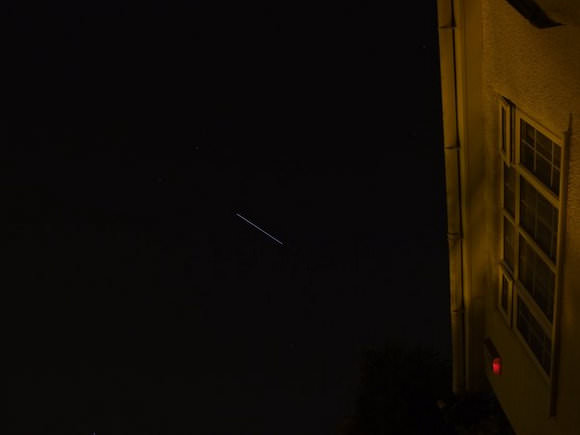[/caption]
As I write this, astronauts from space shuttle Discovery are on the first spacewalk of the STS-119 mission, installing the fourth and final set of solar array wings to the International Space Station. Once the array is deployed, the station will surpass Venus as the brightest object in the night sky, second only to the Moon. This week provides great sighting opportunities for North America and Europe to watch the station/shuttle complex as it passes overhead. You might even be able to take a picture of the event, like Tim Lovell did, who lives in the UK. Tim took this image just a short time ago, on March 19, 2009 at about 21:00 CET . If you’ve never had the opportunity to see the space station fly over your backyard, this is a great chance to do so. And for those of you that have seen the ISS before, you know what a spectacular (and sometimes spine-tingling) sight it is. And now that the station is growing (and while the shuttle is docked) the ISS will be brighter than ever. How can you find out when the station will be flying over your house?
There are a couple of different websites that provide real-time tracking data and information about the ISS sighting opportunities. NASA has a Quick and Easy Sightings by City site, where you just search for your country and city which provides local times and the location in the sky where the station will be visible.
The European Space Agency also provides their ISS: Where Is It Now site that also allows you to select your country and city to find the station’s location.
The Heaven’s Above website (which also powers ESA’s site) is also an excellent site to find out when the ISS, as well as all sorts of other satellites and other heavenly sights will be visible. At Heaven’s Above, you can plug in your exact latitude and longitude, so if you live in a remote area, you’ll be able to have exact times and locations to look for satellites instead of relying on information for the nearest city.
So take this great chance to see our orbiting outpost. If you have a strong enough and tracking-capable telescope you might even be able to spot specific modules on the station, or the solar arrays.
The solar array truss segment, known as Starboard 6 or S6 for short, weighs 14,000 kilograms (31,060 pounds) and measures 5 meters (16.3 feet) wide, 13.8 meters (45.4 feet) long in the shuttle’s cargo bay. Once deployed, the ISS will then have four panels on each end of its power truss. Total surface area of all the arrays will be roughly one acre, generating 84 to 120 kilowatts of useable power, depending on the time of year and angle to the sun.
Thanks to Tim Lovell for sharing his ISS image!


Just hope they don’t drop or toss overboard anything this time.
Taking pictures like this is real easy. Some sort of tripod is pretty much required, but you cannot go wrong.
My guess is that Tim’s picture above was about a 5 second exposure. I did a 30 second one of the exact same pass, from the Netherlands:
http://www.flickr.com/photos/pascalscheffers/3368871168
I took just 5 test pictures of the sky before the actual pass to get focus and metering right. You don’t want to do that on the pass itself. ISS is so much brighter than any stars in your field, it will create a streak if your picture shows stars nicely exposed.
Salacious: your comment put the image in my mind of someone walking alone at night feels something drop on his shoulder. He looks over and see a giant white splotch of what appears to be bird poop. He then looks up just in time to see the shuttle flying overhead!
My mind is a weird place, I tell ya. And yes, the sky really is purple over there.
Dave, if they drop the S6 truss you’ll certainly feel it on your shoulder! Though at least you’ll have a free solar to array to build from scrap…
If you use Twitter, you can follow @satsights – it’s a bot I created that gives notifications of ISS/Shuttle flyovers for (currently) 10 US cities. Notifications are between 5-15 before the flyover event, giving information on how to find the satellite.
Data comes from the NASA sightings pages. Still a work in progress, I’m fine-tuning the text is displays as well as adding daily notifications, so users in different cities get more than 10 minutes notice.
“The solar array truss segment, known as Starboard 6 or S6 for short, weighs 14,000 kilograms (31,060 pounds) and measures 5 meters (16.3 feet) wide, 13.8 meters (45.4 feet) long …”
1 squere meter of the solar array weighs 200 kilograms!!! Why is it so heavy ?
Don’t forget http://www.spaceweather.com for satellite listings.
b.